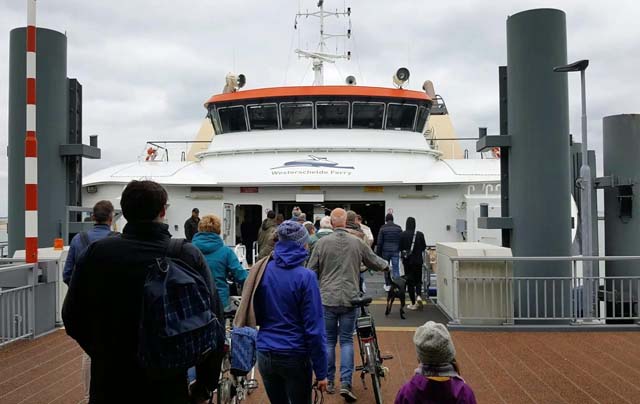Dutch naval architect practice C-Job, along with Flying Fish, MuConsult and Panteia, was recently asked by the Zeeland province and ferry operator Westerschelde to come up with a low-emission solution to a tricky operational problem.
The Westerschelde ferries provide an essential year-round commuter service as well as tourism in the summer months. During the off-season, the ferries run at around 10% of capacity, and, particularly when running in stormy winter weather, fuel use increases, resulting in the service operating at an overall loss.
Johan Schonebaum, Senior Project Manager and Co-Founder of Flying Fish, said: “The province of Zeeland requested us to look at the Westerschelde Ferry operations. The ferry runs between Vlissingen and Breskens. Their aim is to have the ferry service run completely emission-free while preparing the fleet for an increase in passengers using the service. A benefit would be if we could also reduce the Opex.”
Roeland Pieper, Senior Consultant MuConsult, said: “It’s important to first start with what numbers of passengers we may expect. Currently, 80% of passengers using the ferry service are tourists. At its lowest, only 10% of capacity is used during the off-season. This already provides key data, so we build upon that. We used demographic, socio-economic and tourist trends to estimate the anticipated development of the number, type, and distribution of passengers throughout the day in the period 2027 to 2042.”
Schonebaum continued: “Based on the numbers provided by MuConsult and Panteia, it became clear there was an opportunity to optimise operations in addition to replacing the current vessels. Simply replacing the existing ones with two new vessels would still pose the same problem – it would run nearly empty outside of the summer months, while operational cost would remain the same.”
The solution was thought to be a flexible service. To respond efficiently to the peaks and lows of the ferry service, the optimum was believed to be a mixed fleet of three small, fast ships and one large ship, all battery-electric, rather than the present two larger ships running on fossil fuel.
Schonebaum said: “It allows the ferry service to make the most of the conditions as they present themselves while reducing operating costs across the board.”
Eefje Pouls, Junior Project Manager, C-Job said: “For the main vessel we propose a lightweight catamaran, for example made of aluminium, which would have a capacity of 250 passengers. The smaller ships are proposed to be high-speed hydrofoil vessels. These ships could reach speeds of 50 km/h and have space for 42 passengers. Two are required to maintain the ferry service, a third is proposed to support during downtime or maintenance of the other vessels. All vessels are battery-electric and would be able to charge while offloading and loading passengers onboard. Thanks to the higher speeds, more journeys are possible thus passengers would enjoy a quicker journey and increased service.”
The additional capital expense of more vessels was thought to be offset by the zero-emission capability.
Menno Menist, Panteia director said: “This challenge is often seen in many transport and mobility solutions. The question is how to make the transition to zero-emission a reality? Since this question is crucial for the success of the Green Deal, the EC has made co-financing funds available to cover the initial (temporary) losses. With the proposed set-up, the Province of Zeeland could apply for subsidies considering the fleet would be emission-free. This would tackle (part of) the initial losses”
Schonebaum concluded: “The unique proposal for a zero-emission fleet features higher energy efficiency, a more flexible and reliable schedule with lower investment and operating costs, and contributing to cleaner maritime transportation. In short, the new set-up leads to a higher service level and lower cost. A win-win situation for both passengers and local government.”



